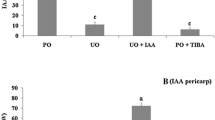Abstract
Indol-3-acetic acid (IAA), gibberellin-like substances (GAs), and abscisic acid (ABA) were measured throughout the first 35 days of fruit development in agar diffusates from seeded and parthenocarpic tomato fruits. Parthenocarpic fruit growth was induced with either an auxin (4-CPA), morphactin (CME) or gibberellic acid (GA3). IAA and GAs were at their highest levels in diffusates during the early stages of fruit growth, whereas diffusible ABA increased later. Most IAA was found in diffusates from auxin-induced and seeded fruits, whereas GAs were at their lowest levels in seeded fruits. There were only minor differences in ABA concentrations regardlesss of the treatments.
Levels of diffusible hormones of tomato fruits may be easily manipulated by inducing parthenocarpic fruit growth. In spite of no obvious relationship between fruit growth and hormone levels in this study, induced parthenocarpy is considered a useful tool to further elucidate the role of hormones in fruit development and sink-source interactions.
Similar content being viewed by others
References
Asahira T, Takeda Y, Nishio T, Hirabayashi M and Tsukamoto Y (1967) Studies on fruit development in tomato. I. Ovule development and control of diffusible auxin in synthetic auxin- and gibberellin-induced parthenocarpic tomato fruits in relation to their development. Mem Res Inst Food Sci, Kyoto Univ 28: 47–74
Bangerth F (1975) Zur Wirkungsweise einiger Substanzen bei der Reduktion der Haltekräfte von Explantaten verschiedener Steinobstarten. Angew Bot 49: 31–39
Bangerth F (1976) A role for auxin and auxin transport inhibitors on the Ca content of artificially induced parthenocarpic fruits. Physiol Plant 37: 191–194
Bangerth F and Sjut V (1978) Induced parthenocarpy-a tool for investigating hormone-regulated physiological processes in fruits. Acta Horticulture 80: 169–174
Barendse GWM (1975) Biosynthesis, metabolism, transport and distribution of gibberellins. In Krishnamoorthy HN, ed. Gibberellins and plant growth, pp 65–89. New Delhi: Wiley Eastern
Beardsell MF and Cohen D (1975) Relationships between leaf water status, abscisic acid levels, and stomatal resistance in maize and sorghum. Plant Physiol 56: 207–212
Blanton WE and Basler E (1976) Abscisic acid and gibberellic acid effects on auxin translocation in persimon seedlings (Abst.) Plant Physiol 57, Suppl. 88
Cooper WC and Horanic G (1973) Induction of abscission at hypobaric pressures. Plant Physiol 51: 1002–1004
DennisJr FG (1977) Growth hormones: Pool size, diffusion, or metabolism? HortScience 12: 217–220
Dörffling K, Böttger M, Martin D, Schmidt V and Borowski D (1978) Physiology and chemistry of substances accelerating abscission in senescent petioles and fruit stalks. Physiol Plant 43: 292–296
Ebert A and Bangerth F (1981) Relations between the concentration of diffusible and extractable gibberellin-like substances and the alternate-bearing behaviour in apple as affected by chemical fruit thinning. Sci Hortic 15: 45–52
Goldschmidt MHM (1977) The polar transport of auxin. Ann Rev Plant Physiol 28: 439–478
Hay JR (1956) The effect of 2,4-dichlorophenoxyacetic acid and 2,3,5-triodobenzoic acid on the transplant of indole-acetic acid. Plant Physiol 31: 118–120
Hoad GV (1978) The role of seed derived hormones in the control of flowering on apple. Acta Horticulture 80: 93–103
Kamisaka S and Larsen P (1977) Improvement of the indole-α-pyrone fluorescence method for quantitative determination of endogenous indole-3-acetic acid in lettuce seedlings. Plant Cell Physiol 18: 595–602
Nitsch JP (1971) Perennation through seeds and other structures: Fruit development. In Stewart FC, ed. Plant physiology, Vol. VI A, pp. 413–501. New York: Academic Press
Patrick JK (1982) Hormonal control of assimilate transport. In Wareing PF, ed. Plant growth substances, pp. 669–678. London: Academic Press
Sastry KKS and Muir RM (1963) Gibberellin: Effect on diffusible auxin in fruit development. Science 140: 494–495
Schneider G (1970) Morphactins: Physiology and performance. Ann Rev Plant Physiol 21: 499–536
Scott TK and Most BH (1972) The movement of growth hormones in sugar cane, In Kaldewey H and Vardar Y, ed. Hormonal regulation in plant growth and development, pp. 57–67. Weinheim: Verlag Chemie
Sjut V and Bangerth F (1981) Effect of pollination or treatment with growth regulators on levels of extractable hormones in tomato ovaries and young fruits. Physiol Plant 53: 76–78
Sjut V and Bangerth F (1983) Induced parthenocarpy-a way of manipulating levels of endogenous hormones in tomato fruits (Lycoperiscon esculentum Mill.). 1. Extractable hormones. Plant Growth Reg 1(3): 243–251
Walker AJ and Ho LC (1977) Carbon translocation in the tomato: Carbon import and fruit growth. Ann Bot 41: 813–823
Author information
Authors and Affiliations
Rights and permissions
About this article
Cite this article
Sjut, V., Bangerth, F. Induced parthenocarpy-a way of manipulating levels of endogenous hormones in tomato fruits (Lycopersicon esculentum Mill.) 2. Diffusible hormones. Plant Growth Regul 2, 49–56 (1984). https://doi.org/10.1007/BF00024095
Received:
Revised:
Accepted:
Issue Date:
DOI: https://doi.org/10.1007/BF00024095




